Related Research Articles

Tiziano Vecelli or Vecellio, known in English as Titian, was an Italian (Venetian) painter during the Renaissance, considered the most important member of the 16th-century Venetian school. He was born in Pieve di Cadore, near Belluno. During his lifetime he was often called da Cadore, 'from Cadore', taken from his native region.

Artemisia Lomi or Artemisia Gentileschi was an Italian Baroque painter. Gentileschi is considered among the most accomplished seventeenth-century artists, initially working in the style of Caravaggio. She was producing professional work by the age of fifteen. In an era when women had few opportunities to pursue artistic training or work as professional artists, Gentileschi was the first woman to become a member of the Accademia di Arte del Disegno in Florence and she had an international clientele.
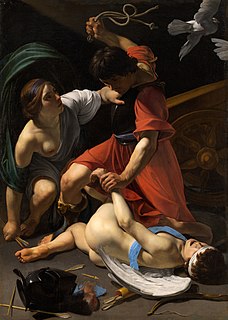
The Caravaggisti were stylistic followers of the late 16th-century Italian Baroque painter Caravaggio. His influence on the new Baroque style that eventually emerged from Mannerism was profound. Caravaggio never established a workshop as most other painters did, and thus had no school to spread his techniques. Nor did he ever set out his underlying philosophical approach to art, the psychological realism which can only be deduced from his surviving work. But it can be seen directly or indirectly in the work of Rubens, Jusepe de Ribera, Bernini, and Rembrandt. Famous while he lived, Caravaggio himself was forgotten almost immediately after his death. Many of his paintings were reascribed to his followers, such as The Taking of Christ, which was attributed to the Dutch painter Gerrit van Honthorst until 1990. It was only in the 20th century that his importance to the development of Western art was rediscovered. In the 1920s Roberto Longhi once more placed him in the European tradition: "Ribera, Vermeer, La Tour and Rembrandt could never have existed without him. And the art of Delacroix, Courbet and Manet would have been utterly different". The influential Bernard Berenson stated: "With the exception of Michelangelo, no other Italian painter exercised so great an influence."

Giuseppe Cesari was an Italian Mannerist painter, also named Il Giuseppino and called Cavaliere d'Arpino, because he was created Cavaliere di Cristo by his patron Pope Clement VIII. He was much patronized in Rome by both Clement and Sixtus V. He was the chief of the studio in which Caravaggio trained upon the younger painter's arrival in Rome.

Orazio Lomi Gentileschi (1563–1639) was an Italian painter. Born in Tuscany, he began his career in Rome, painting in a Mannerist style, much of his work consisting of painting the figures within the decorative schemes of other artists. After 1600, he came under the influence of the more naturalistic style of Caravaggio. He received important commissions in Fabriano and Genoa before moving to Paris to the court of Marie de Medici. He spent the last part of his life at the court of Charles I of England. He was the father of the painter Artemisia Gentileschi.

Agostino Tassi was an Italian landscape and seascape painter, who was convicted of raping Artemisia Gentileschi in 1612.

The three Le Nain brothers were painters in 17th-century France: Antoine Le Nain (c.1600–1648), Louis Le Nain (c.1603–1648), and Mathieu Le Nain (1607–1677). They produced genre works, portraits and portrait miniatures.
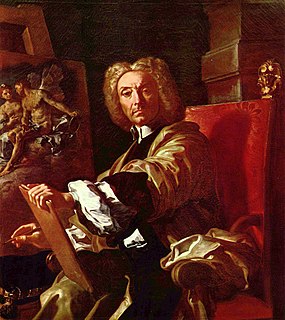
Francesco Solimena was a prolific Italian painter of the Baroque era, one of an established family of painters and draughtsmen.

The Basilica of San Giovanni dei Fiorentini is a minor basilica and a titular church in the Ponte rione of Rome, Italy.
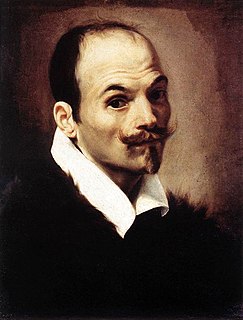
Orazio Borgianni was an Italian painter and etcher of the Mannerist and early-Baroque periods. He was the stepbrother of the sculptor and architect Giulio Lasso.
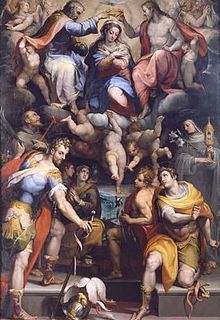
Orazio Samacchini was an Italian painter of the late-Renaissance and Mannerist style, active in Rome, Parma, and his native city.

Aurelio Lomi was an Italian painter of the late-Renaissance and early-Baroque periods, active mainly in his native town of Pisa, Tuscany.

Orazio Riminaldi was an Italian painter who painted mainly history subjects in a Caravaggist style.
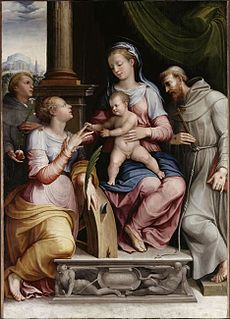
Orazio Alfani was an Italian painter of the Renaissance period, active in both Palermo and Perugia.
Orazio Vecellio was an Italian painter of the Renaissance period, born in Venice around 1528. The son and pupil of Titian, he distinguished himself as a painter of portraits, some of which were thought little inferior to those of his father. He occasionally painted historical subjects; one of the most important was destroyed in the conflagration in the ducal palace at Venice. He neglected painting to devote himself to alchemy. He died of the plague in Venice, in 1576, the same year as his father.
Orazio Ludovisi (1561–1624) was an Italian nobleman, military commander and patrician of Bologna. During his brother's reign as Pope Gregory XV, he became Commander of the Papal Armies and Duke of Fiano and Zagarolo.
Orazio is a male given name of Italian origin, derived from the Latin name (nomen) Horatius, from the Roman gens (clan) Horatia.
Francesco Foschi was an Italian painter best known for painting winter landscapes.

Giovanni Francesco Guerrieri (1589–1655) was an Italian painter and Caravaggisto.
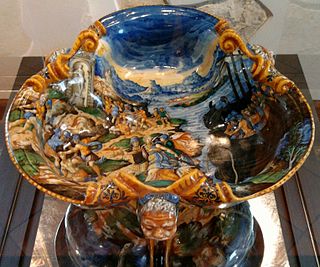
Orazio Fontana (1510–1571) was an Italian potter and maiolica painter, who introduced istoriato maiolica in Urbino.
References
- Bryan, Michael (1889). Walter Armstrong; Robert Edmund Graves (eds.). Dictionary of Painters and Engravers, Biographical and Critical. Vol. II L-Z. London: George Bell and Sons. p. 386.